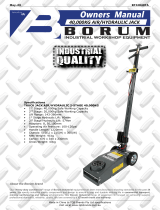
11/21 Product Code: 3032T
Made in China to TQB Brands Pty Ltd Specifications Page 7
Visit us at www.tqbbrands.com.au
4. OPERATION
Prior to each use always conduct a visual inspection checking for leaks and any abnormal conditions, such as cracked welds,
leaks, and damaged, loose, or missing parts.
Abrasive Selection:
The type of media you choose will greatly influence the amount of time needed to clean a given surface area. TradeQuip’s
recommended blasting media materials include garnet, glass beads, steel grit and soda bi-carbonate. Some of these will
absorb moisture much more readily than the others depending on the humidity. As a result, this may cause clogging of the
media metering valve. If this occurs, empty the abrasive media material from the tank, clear the clogging of the media
metering valve and ensure the replacement media is clean and dry.
If you decide to continue to re-use abrasive media for prolonged periods, remember it does wear out. The sharp edges
become rounder, and are less effective. It’s at the point you should replace the batch of abrasive media you are using.
Loading Abrasive:
1. Check that the new bag of abrasive media is dry and won’t clog the meter valve (19B), media outlet pipe (25), hose
(24) or other components.
2. Always wear personal protective gear.
3. Turn the air supply valve (18) to the off (horizontal) position.
4. Open the blast gun nozzle (42) (vertical) position.
5. Ensure the pressure gauge (17) reads zero ("0 psi") pressure.
6. Remove the filler cap (13) from the top of the tank.
7. Insert the funnel (27) and pour the abrasive into the funnel. Be sure to load enough into the tank to do the job at
hand. If it is a big job, fill the tank only ¾ full and reload as needed to finish the work.
8. Note: if the humidity is 90-100% the water trap (18) won’t be able to trap all of the moisture in a ¾ full tank.
Reduce the amount of abrasive, load more frequently and empty the water trap frequently. This will reduce the
possibility of clogging the bottom of the tank or line.
9. With the correct amount of abrasive in the tank close the filler cap (13).
10. Close the nozzle shut-off valve (42) and open the air supply valve (18).
11. Check for air leaks at the filler cap as you begin to pressurise the tank from the compressor.
Correct Air Pressure:
Pressure should not exceed 125psi. If pressure exceeds 125psi the safety relief valve (11) is designed to release the excess
pressure. If this does not happen stop all work immediately and use the air compressor to reduce the excess pressure. Do
not investigate the blaster’s pressure until the pressure gauge (16) reads zero.
To Setup for Abrasive Blasting
Note: Start with all valves in closed position.
1. Point the blasting gun to a safe direction away from people, pets or anything around you that may be damaged by
abrasive spray.
2. Press and hold blasting gun until air starts flowing through the trigger
3. While pressing and holding the blasting gun, slowly open the abrasive control valve until abrasive material begins
to flow out of the blasting gun
4. Adjust the abrasive valve to an appropriate position (about 45º) when desired amount of abrasive material is
flowing through the trigger nozzle
To Begin Blasting
1. Choose a larger nozzle for a broader spray pattern. Choose a smaller nozzle for more focussed abrasive blasting
2. Adjust abrasive flow with the abrasive control valve
3. Be aware of abrasive clogging the system. Depressurise if necessary and replace the abrasive media with drier or
cleaner abrasive media
To Stop Blasting
1. Whilst continuing to press and hold the blasting gun, turn the abrasive control valve to the closed position
2. When noticing only air is coming through the gun, stop the air flow by releasing the gun



















